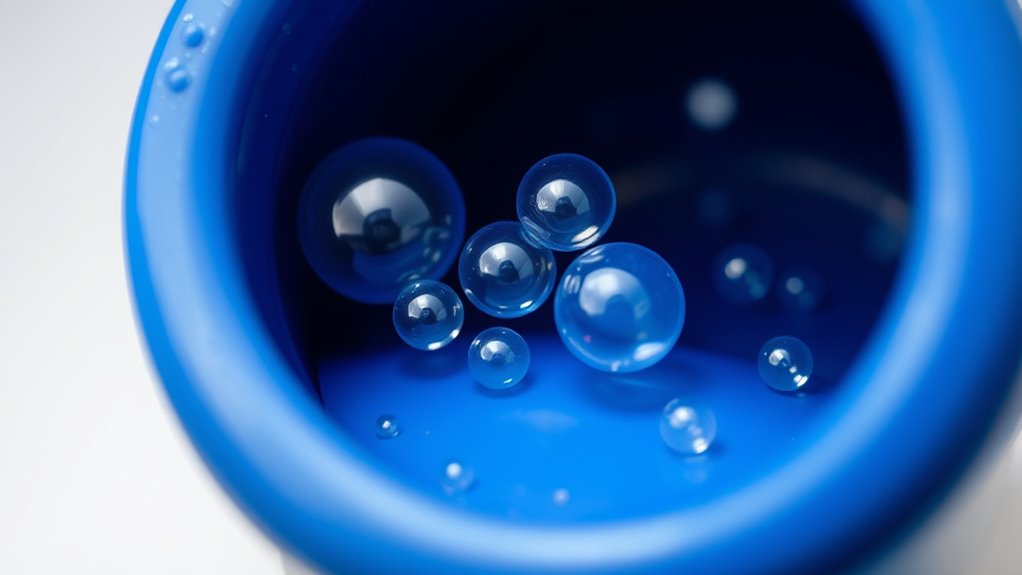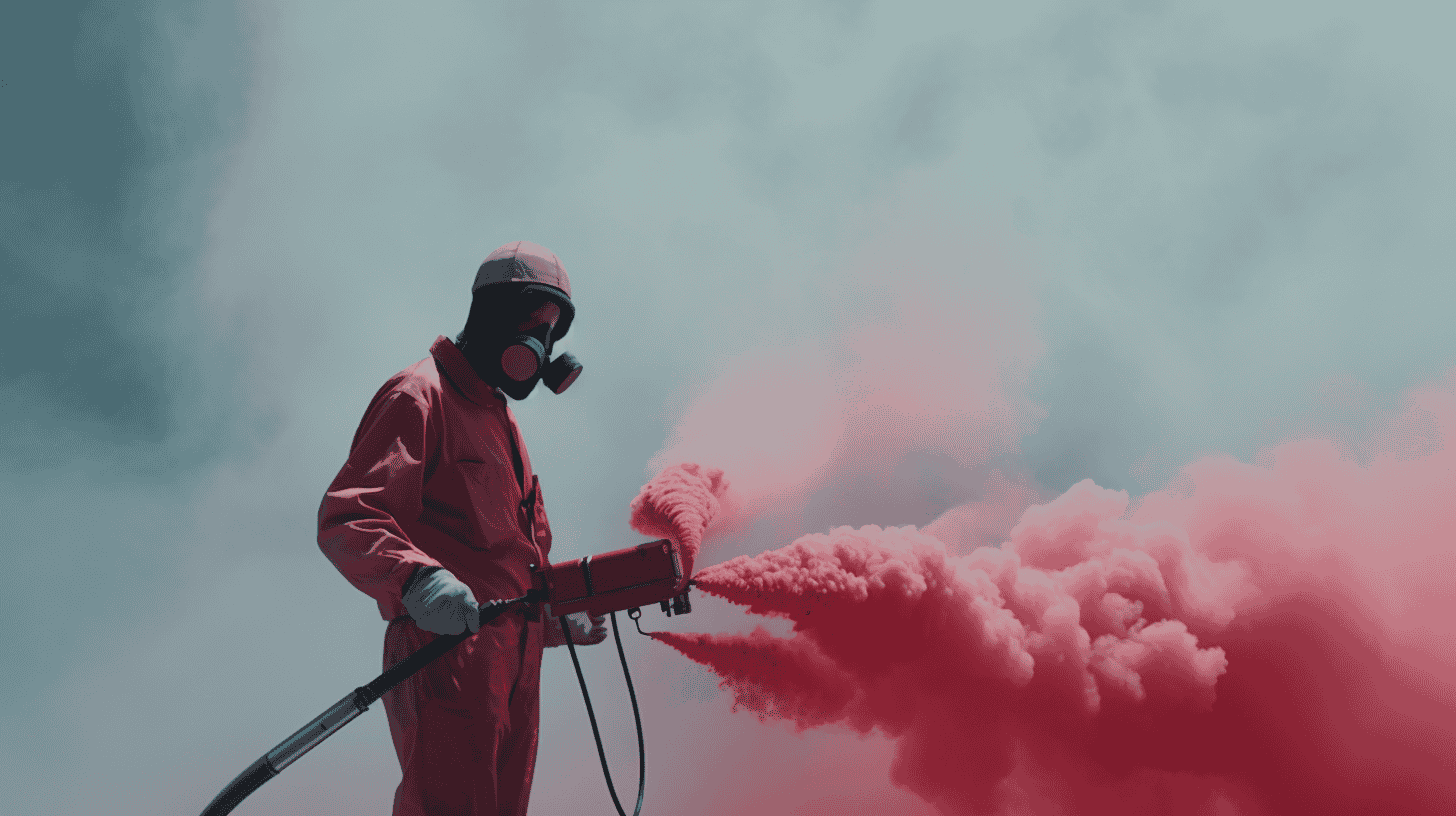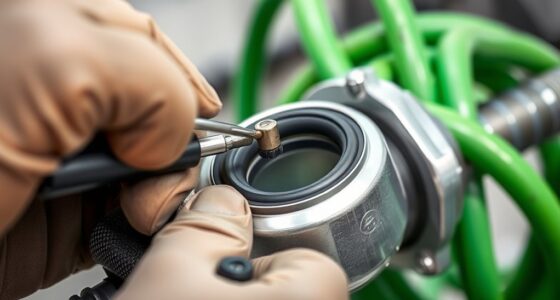To spot air entrapment in your airless paint system, look for surface bubbles or foam that appear during spraying, which indicate trapped air escaping. Notice uneven spray patterns, drips, or misting that suggest inconsistent paint flow. Listen for unusual noises like gurgling or knocking sounds, and check for pressure fluctuations or drops that point to air pockets. Recognizing these signs helps you address issues early—keep going to learn more about preventing and fixing them.
Key Takeaways
- Look for visible air bubbles or foam in the paint flow during spraying.
- Notice inconsistent spray patterns, sputtering, or sudden drops in paint flow.
- Listen for unusual noises like gurgling or knocking from the pump.
- Observe surface irregularities such as dull patches or bubbling after application.
- Check for fluctuations in pressure readings or vibrations indicating air pockets.
Recognizing Visible Bubbles and Foam on the Surface
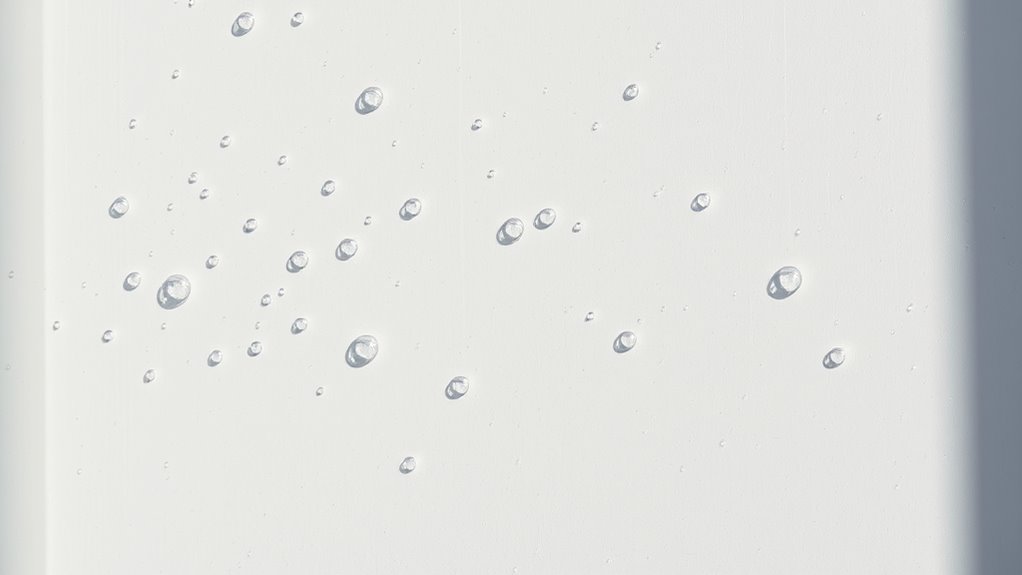
When inspecting an airless paint surface, look for visible bubbles or foam forming on the paint’s surface. These bubbles often indicate trapped air escaping and can cause surface discoloration over time. You might also notice equipment vibrations during spraying, which suggest inconsistent paint flow and increased risk of air entrapment. Surface discoloration, such as dull or uneven patches, can be a sign that air bubbles are disrupting the coating’s uniformity. Pay attention to these visual cues and operational signs, as they help identify issues early. Proper airless paint system setup and maintenance can significantly reduce the likelihood of air entrapment. Ensuring the proper equipment configuration and consistent application techniques will help prevent bubble formation. Regular inspection procedures and adherence to manufacturer guidelines are essential for optimal performance. Addressing bubbles and foam promptly guarantees a smooth, professional finish and reduces the chance of future peeling or cracking caused by trapped air. Additionally, implementing preventative maintenance practices can further minimize the risk of air entrapment by ensuring all equipment functions correctly. Always monitor both the surface and equipment behavior during application.
Noticing Uneven Spray Patterns and Drips

Uneven spray patterns and drips are clear indicators that air might be trapped in your paint system. When air gets in, it disrupts the paint’s consistency, causing inconsistent flow and uneven coverage. You may notice areas where the spray arcs or drips appear unexpectedly, signaling a problem. Nozzle clogging often accompanies these issues, as trapped air can cause paint to sputter or splatter. To address this, check your paint’s consistency; if it’s too thick or thin, it can trap air more easily. Regularly inspect and clean your nozzle to prevent clogs, which can worsen uneven spray patterns. Ensuring proper fluid pressure and smooth paint flow helps eliminate air pockets, resulting in a more uniform spray and a professional finish. Additionally, monitoring your paint’s viscosity can help prevent air entrapment, as improper paint viscosity increases the likelihood of air getting trapped during spraying.
Listening for Unusual Sounds During Operation

Unusual sounds during operation can be a strong indicator that air is trapped in your airless paint system. You might notice sound anomalies like irregular pitches or inconsistent rhythms, signaling internal issues. Vibration cues often accompany these noises, feeling more pronounced or uneven than normal. Pay attention to:
Unusual sounds and vibrations signal trapped air in your airless paint system.
- High-pitched squeals that fluctuate with spray pressure
- Rhythmic knocking or banging sounds
- Gurgling or bubbling noises in the pump
- Sudden drops in motor noise or humming
- Vibrations that feel irregular or more intense than usual
These cues suggest air pockets are interfering with the system’s flow. Listening carefully can help you identify these early warning signs before they cause more significant problems, ensuring smoother operation and better paint application. Additionally, ongoing air entrapment detection measures in system design can help mitigate risks associated with equipment malfunctions. Being aware of system performance fluctuations can also aid in early detection and resolution of air entrapment issues. Monitoring air release during operation can further assist in preventing these issues from escalating. Regularly checking for internal air pockets can help maintain optimal system function and prevent costly repairs.
Monitoring Pressure Fluctuations in the System
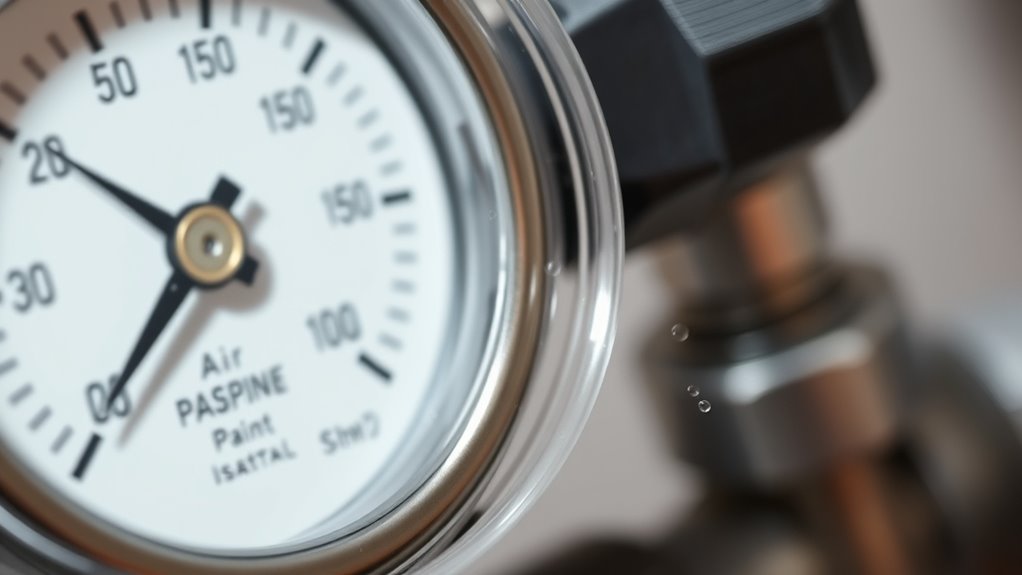
Monitoring pressure fluctuations is essential for detecting air entrapment in your airless paint system. Keep a close eye on your pressure gauge during operation. Sudden drops or irregular spikes in pressure often indicate trapped air disrupting flow. Additionally, observe the flow rate; inconsistent or fluctuating flow suggests that air pockets are interfering with paint delivery. If you notice these signs, it’s a strong indicator of air entrapment. Regularly checking pressure stability helps you catch issues early, preventing uneven coating or equipment damage. By maintaining steady pressure and flow readings, you guarantee ideal system performance and a smooth finish. Always compare readings to manufacturer specifications to identify abnormal fluctuations that point to air entrapment. Understanding how arcade machines operate can also help in troubleshooting, as improper settings can contribute to system inefficiencies. Furthermore, implementing system diagnostics can aid in identifying underlying causes of pressure irregularities and improve overall performance. Conducting pressure testing procedures can further assist in pinpointing leaks or blockages that lead to fluctuations. For added assurance, inspecting paint viscosity and ensuring proper mixing can minimize the risk of air pockets forming within the system. Additionally, maintaining proper airless spray equipment maintenance routines can prevent many common issues related to air entrapment.
Identifying Excessive Overspray or Thinning Coats

Have you noticed paint layers that seem thinner or more widespread than intended? This could indicate excessive overspray or thinning coats caused by air entrapment. Poor spray consistency often results from nozzle clogging or inconsistent pressure, leading to uneven application. Watch for signs like paint drifting beyond target areas, a misty spray pattern, or coats that don’t fully cover surfaces. You might also see an increase in overspray around the edges or find that the paint appears more transparent. These issues suggest air bubbles are disrupting the flow, causing uneven spray and thinner layers. Addressing nozzle clogging promptly and maintaining proper pressure can improve spray consistency, helping you achieve smooth, even coats without excess overspray. Additionally, understanding the sound healing science behind proper equipment operation can help in troubleshooting and maintaining optimal spray conditions. Recognizing how air entrapment affects spray patterns can further aid in preventing these issues through proper technique and equipment maintenance. Being aware of projector contrast ratios and their impact on image quality can also be useful when diagnosing issues related to uneven or inconsistent spray layers, as both involve the importance of optimal conditions for clarity and detail. Regularly inspecting and cleaning your spray equipment can significantly reduce the risk of clogged nozzles, ensuring more consistent application. Moreover, monitoring credit card statements can help detect any fraudulent activity that might compromise your equipment or supplies.
Frequently Asked Questions
Can Air Entrapment Cause Long-Term Damage to the Paint Equipment?
Air entrapment can cause long-term damage to your paint equipment if ignored. It affects paint viscosity and leads to inconsistent spray patterns, which strain the system. Over time, trapped air can cause wear and tear, requiring more frequent equipment maintenance and risking costly repairs. Regularly checking for air pockets and maintaining proper pressure levels helps prevent such damage, ensuring your equipment stays in good shape and performs efficiently.
What Safety Precautions Should Be Taken When Dealing With Air Bubbles?
Dealing with air bubbles can feel like handling a ticking time bomb! Always wear protective gear like goggles, gloves, and masks to shield yourself from splatters. Make certain proper ventilation precautions are in place to avoid inhaling fumes or airborne particles. Keep your workspace well-ventilated and avoid working in confined spaces. These safety steps help prevent accidents and keep you safe while managing air bubbles in paint systems.
How Often Should I Inspect for Air Entrapment During a Job?
You should perform visual checks for air entrapment regularly throughout your project, ideally every 15 to 20 minutes. The inspection frequency depends on the job size and complexity, but consistent monitoring guarantees early detection. During these checks, look for bubbles or inconsistent spray patterns. Catching air entrapment early helps prevent defects, so stay vigilant and conduct frequent inspections to maintain a smooth, professional finish.
Are Certain Types of Paint More Prone to Air Entrapment Issues?
Certain paints are more prone to air entrapment because of their viscosity and how they interact with nozzle design. Thicker paints with high viscosity tend to trap air more easily, especially if the nozzle isn’t optimized for smooth flow. You should pay close attention to these factors, adjusting your equipment and paint type accordingly, to prevent bubbles and guarantee a smooth, professional finish.
Can Temperature Fluctuations Affect Air Bubble Formation in the System?
Temperature effects can considerably influence bubble formation in your airless paint system. When temperatures fluctuate, the paint’s viscosity changes, causing inconsistent flow and increasing the chances of air bubbles forming. Cooler temperatures may thicken the paint, trapping air, while warmer conditions can cause rapid paint flow, drawing air into the system. To minimize bubble formation, maintain a consistent temperature during mixing and application, ensuring smoother operation and better finish quality.
Conclusion
By keeping an ear tuned to the whispers of your equipment and eyes alert for shimmering bubbles or uneven coats, you become a skilled navigator in the world of airless paint systems. Spotting air entrapment is like catching shadows before they stretch into trouble. With vigilance, you can steer clear of costly mistakes and guarantee a flawless finish, transforming a simple paint job into a masterpiece painted with confidence and precision.
